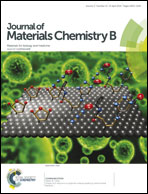Development of dual ligand-targeted polymeric micelles as drug carriers for cancer therapy in vitro and in vivo†
Abstract
Chemotherapy is a major therapeutic approach for cancer patients. The action sites of cancer drugs are intracellular compartments including cytoplasm or nucleus. However, targeting drug delivery into the nucleus of specific tumor cells remains a challenging task. Herein, we developed dual-decorated polymeric micelles with folic acid (FA) and a nuclear localization signal (NLS) for specific tumor-targeted drug delivery. Cholesterol-modified glycol chitosan (CHGC) was synthesized. NLS and FA conjugated CHGC (NFCHGC) micelles were constructed. Doxorubicin (DOX) was chosen as a model anticancer drug and coumarin 6 (C6) was used as a hydrophobic fluorescence probe. The drug-loaded polymeric micelles were prepared and characterized. C6-loaded NFCHGC (C6/NFCHGC) showed efficient intracellular trafficking including endosomal/lysosomal escape and nucleus transportation in folate receptor (FR)-positive KB cells investigated by confocal laser scanning microscopy (CLSM). DOX-loaded NFCHGC (DOX/NFCHGC) exhibited stronger cytotoxicity against KB cells than other DOX formulations. Furthermore, blank polymeric micelles displayed low toxicity and good biocompatibility in vivo. DOX/NFCHGC micelles had the strongest anti-tumor efficacy against KB tumor xenograft models in vivo. These findings demonstrated that NFCHGC micelles were deemed as a potential drug nanocarrier for cancer therapy, especially used in FR-positive tumor cells and nucleus-targeting delivery.


 Please wait while we load your content...
Please wait while we load your content...